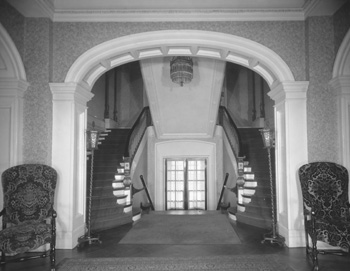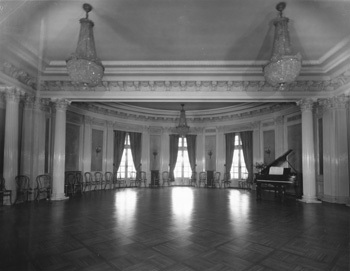 The Governor's Mansion has served as the residence of Kentucky's governors since 1914, with Governor James B. McCreary the first to reside there. It was designed in the grand and monumental style of architecture, called Beaux Arts, by C.C. and E.A. Weber of Fort Thomas. It was modeled after the Petit Trianon, Queen Marie Antionette's villa near the palace of Versailles in France.
The Governor's Mansion has served as the residence of Kentucky's governors since 1914, with Governor James B. McCreary the first to reside there. It was designed in the grand and monumental style of architecture, called Beaux Arts, by C.C. and E.A. Weber of Fort Thomas. It was modeled after the Petit Trianon, Queen Marie Antionette's villa near the palace of Versailles in France.
Land for the mansion cost $9,500 in 1912. The building cost $62,000 and $20,000 was appropriated for furnishings.
 Nearly 80 feet wide and 200 feet long, the 25-room mansion has walls of solid brick, faced with Bowling Green limestone. The basement is carved into the solid rock on which the building rests. The front portico is graced with eight ionic columns that rise two stories. A stone balustrade and terrace create an impressive entrance.
Nearly 80 feet wide and 200 feet long, the 25-room mansion has walls of solid brick, faced with Bowling Green limestone. The basement is carved into the solid rock on which the building rests. The front portico is graced with eight ionic columns that rise two stories. A stone balustrade and terrace create an impressive entrance.
The formal reception rooms all open off the gracious cross hallways. The state dining room, with large semi- circular bay and tall windows, provides a wonderful view during dinner. Most light fixtures and decorative features, such as the ornamental plaster and mantels, are original to the building. From the center hallway, double stairways wind gracefully upward to the private living quarters.
 The Governor's Mansion was added to the National Register of Historic Places in 1972. During 1980-83, the mansion underwent a major renovation which included completion of the simple, formal garden that was based on the original 1913 drawings of the mansion and grounds.
The Governor's Mansion was added to the National Register of Historic Places in 1972. During 1980-83, the mansion underwent a major renovation which included completion of the simple, formal garden that was based on the original 1913 drawings of the mansion and grounds.
The Governor's Mansion contains many furnishings and works of art which are of museum quality. Several items of furniture have a long association with the mansion. These include the state dining room table and chairs, the bombe chest in the governor's reception room and the large pier mirrors on the stair landing, which were moved from the Old Governor's Mansion. The candelabra in the state dining room are the only items in the mansion associated with our first governor, Isaac Shelby.
The Governor's Mansion is both a private home and a public building. It serves as the center of the first family's ceremonial, social, and political activities and is the proudest possession of every Kentuckian.